SPIDERS
page 2--Trichonephila clavipes (Golden Silk Spider)
This
page was born 11/23/2002. Rickubis designed it.
(such as it
is.) Last update: 04/14/2022
Images
and contents on this page copyright ©2002-2022
Richard M. Dashnau spiders page 1 3 4 5 6 7 8
Go back to my
home page, Welcome
to rickubis.com
Go
back to the RICKUBISCAM
page.
This
is my second page of information about spiders. Since I've
looked at
this
species so often, I've decided to put all of my information on
Golden
Silk
Spiders in one area. These
spiders make excellent photo subjects for a
number of reasons. One is that they are so large, that many
external
details
are easy to see. Another is that they are quite docile,
and
will not run
off when approached, and sit well for photos. I think the
Nephila
clavipes
are beautiful spiders, and have been fortunate to be able to see
so
many.
These spiders do
not favor a large variety of habitats, and don't exist
in most other areas of the United States. By
the way, I recommend a book I've bought to anyone who is
interested
in spiders.
The title is: Biology of Spiders, by Rainer F. Foelix, published
in 1996.
Sept 27, 2020 (update 10/25/2020)
This
is more material that I filmed 9/27/20 (the same day I filmed
the
mother gator bellowing).
Just another of the interesting things I saw during the 5 hours
I
walked the trails on that day. As of today, I haven't been
back to BBSP since. At
this time of year (October) most of the Golden Silk Orbweaver
spiders
have attained their full size. It seems to me
that the male spiders
are gone for the season (or the year). I haven't verified
this in
"the literature", but I rarely see any males in the webs at this
time
of
year-so I assume that they've done their work,
and have been eaten or
just died. I don't know if the males die automatically
after
they've fertilized a female, as some other orb-weaver species
do. By
the way, the taxonomic name for Golden
Silk
Orbweaver spiders has changed from Nephila
clavipes to Trichonephila clavipes.
It appears that this redefinition was put
forward in a paper published in 2018 (as far as I can tell).
This is the paper:
"Golden
Orbweavers Ignore Biological Rules: Phylogenomic and Comparative
Analyses Unravel a Complex Evolution of Sexual Size Dimorphism"
M. KUNTNER,, C. HAMILTON, et. al. (link: https://academic.oup.com/sysbio/article/68/4/555/5229942
thanks to TurnFear2Fascination on
Twitter (@Tone_Killick)) and I first saw this new name in
a
tweet by @GinaGoesOutside .
I
was happily looking at the spiders, when I saw one start working
on a
leaf that had blown into its web. I've tried filming this
activity many
times. I find it satisfying to see how the spider deftly
trims
away
the strands of web that have stuck to the leaf, snipping a
strand
at a time, until the leaf comes free and she drops it.
Usually the web hasn't been damaged much, so there is
little
repair necessary.
In this case, the wind was blowing pretty
forcefully, so the video was a bit shaky. But I have
edited
it,
and also included a replay where I've cropped the video (to
"zoom in")
and also slowed it down 5
times. That is, I forced it to play
back from the original 60fps to 12fps. I could slow it
more,
but
this rate still allows from some "flow" in movement.
The images below are frames from the video.
The video is
linked here.
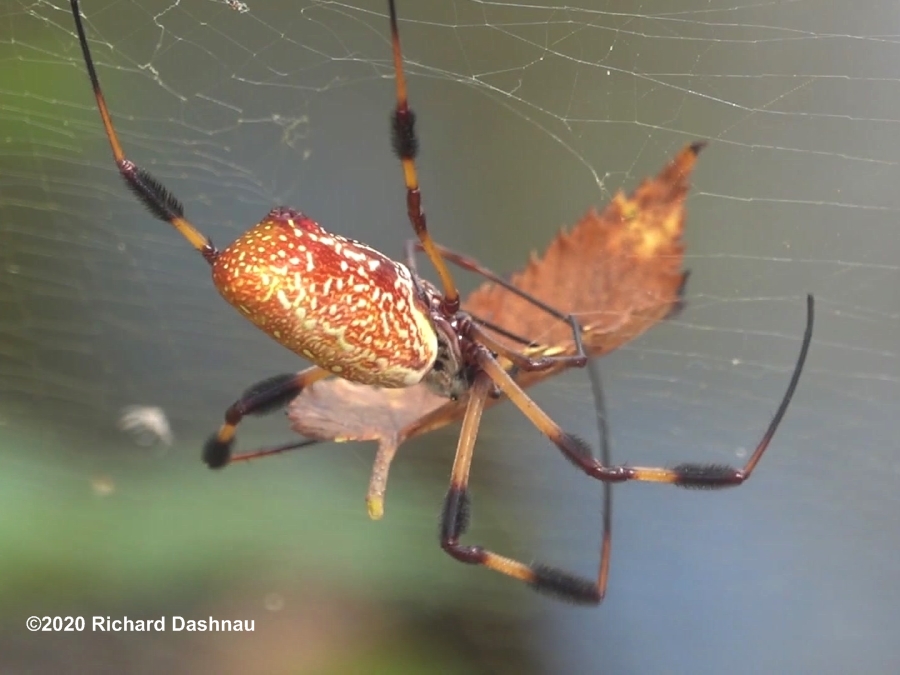
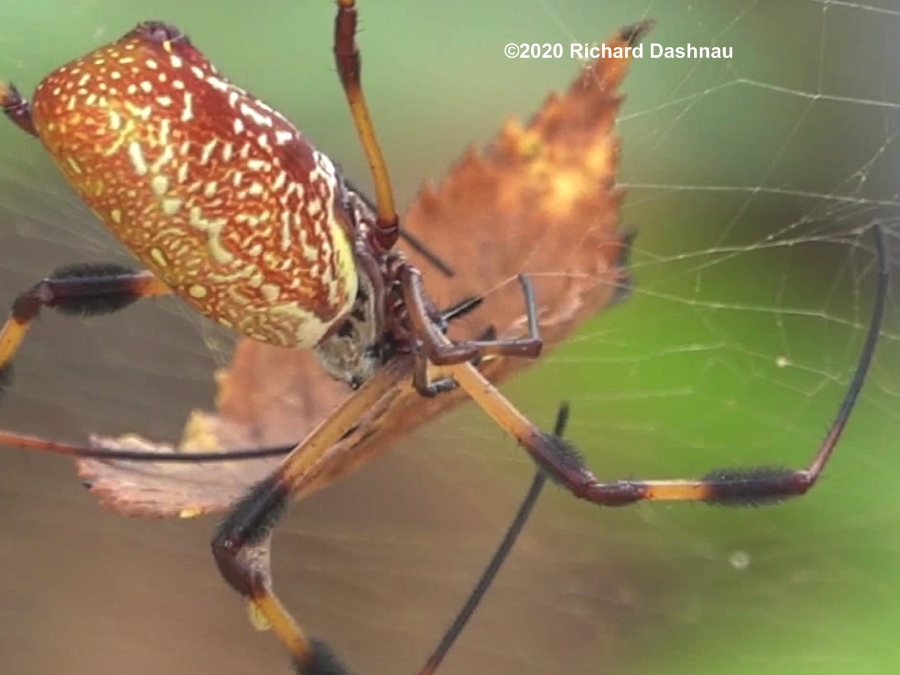
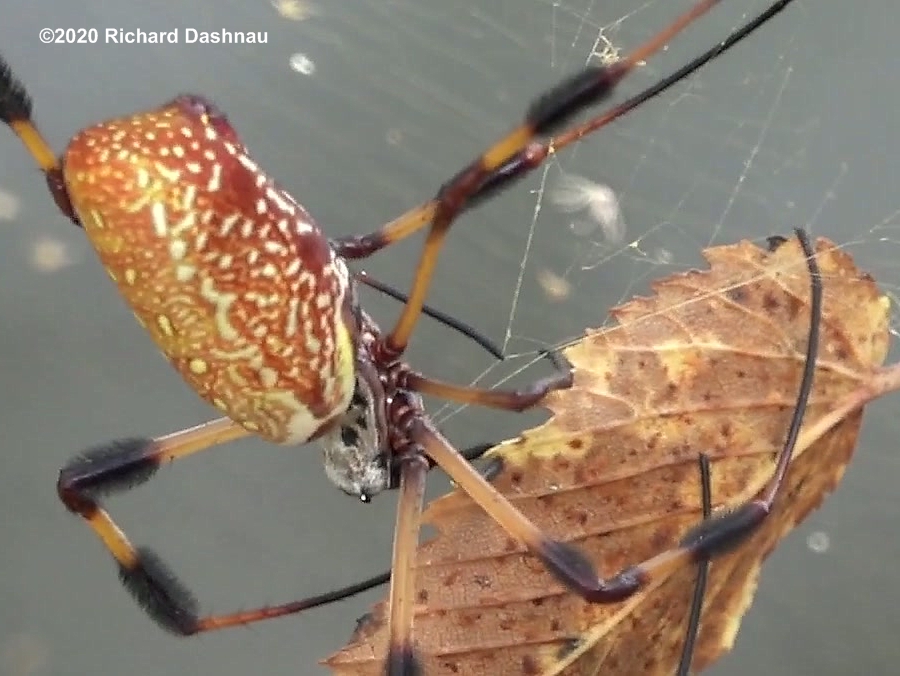
In
the video, I point out where the spider tugs or jerks on her web
at
various times. I've seen this before, and it seems to
be associated
to disturbances of the web. I've seen it when prey hits
the
web,
or after the spider has subdued and/or eaten prey and-of
course-when something inanimate is removed from the web (like
here).
In the clip, she tugs the web after the leaf has been
removed.
I've
found reference to T. clavipes "plucking" the web in some
of
the
literature I've read about these spiders, and it may be the same
behavior. Since the web is so large, it's hard to
capture the act of "plucking"
along with any effects that may
result among the strands. Here are some papers where I've
seen "plucking" mentioned:
1) "THE
PREDATORY BEHAVIOR OF
THE GOLDEN-WEB SPIDER NEPHILA CLAVIPES"; BY MICHAEL H. ROBINSON
AND
HEATH MIRICK (p. 128)
2)
"Size differences in predatory responses of Nephila clavipes
(L.)
spiderlings" ; by Elizabeth M. Hill, Susan G. Brown and Terry E.
Christenson (p. 386)
Try
watching the video and see if you get the same feeling of
accomplishment that I do when I see that leaf dropped free of
the web.
September
5, 2010 I
was walking down the Spillway Trail with a friend I met at the
park.
I'd
stopped to look at some Golden Silk Spiders. While I looked at
them, my
friend looked elsewhere. Then she pointed
and said, "Look at that
big one!"
I
looked,
and it was a big female--but she was REALLY big. Distended. Then
my
friend
said, "I think she has something." I picked up my binoculars, and
looked.
And looked again.
And a third time. I saw something green, with two large
black eyes. It was a FROG! The spider was still eating it, and it
appeared
to be working just behind the head. Beyond that, there was just
the
vertebral
column.
The rest of the frog's body was already gone. While I crouched
to get a close picture, I bumped a log, which bumped the web. This
scared
her off the frog. I was disappointed, but it was still a good
photo
opportunity.
While
we watched, this hugely distended female suddenly ran to the edge
of
her
web, and grabbed something else! When she brought it to the center
of
the
web, I saw that it was a horsefly. She wrapped it, which I
filmed a bit,
and then-to my surprise-she began eating! I've read about what
these
large
spiders can catch with their webs. I've read that birds might
sometimes
be caught. I've seen large insects ensnared. I suppose
that anything that
the spider can overpower, and then render into drinkable slurry
with
its
digestive juices, is is potential food. But, I'd never considered
that
frogs could be on the list. I can't imagine how it got caught in
the web.
The images below show the pieces of this story. The last 3
images are frames from the video
clip
(mp4)
-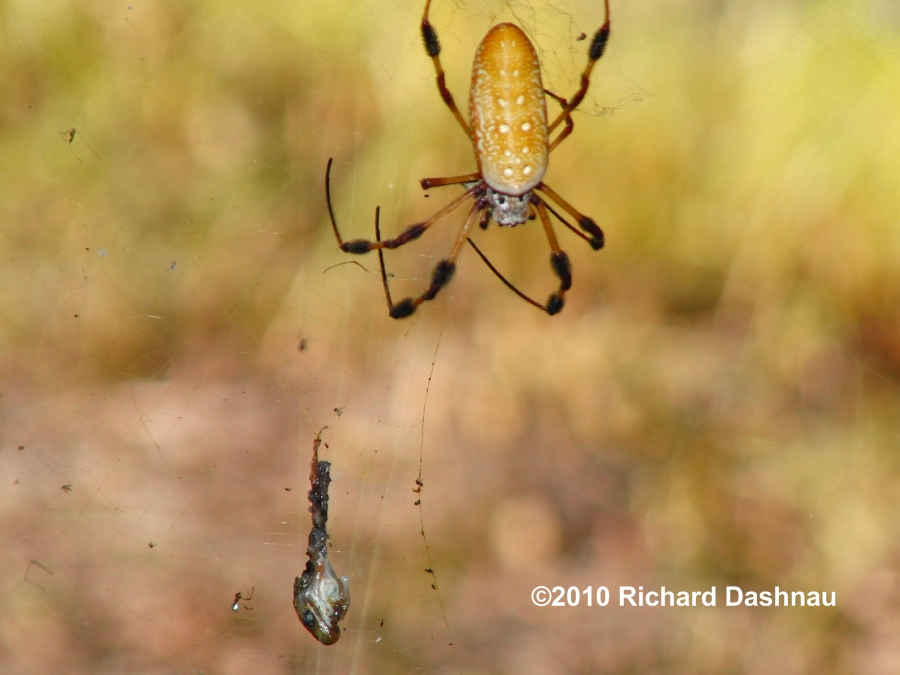 -
-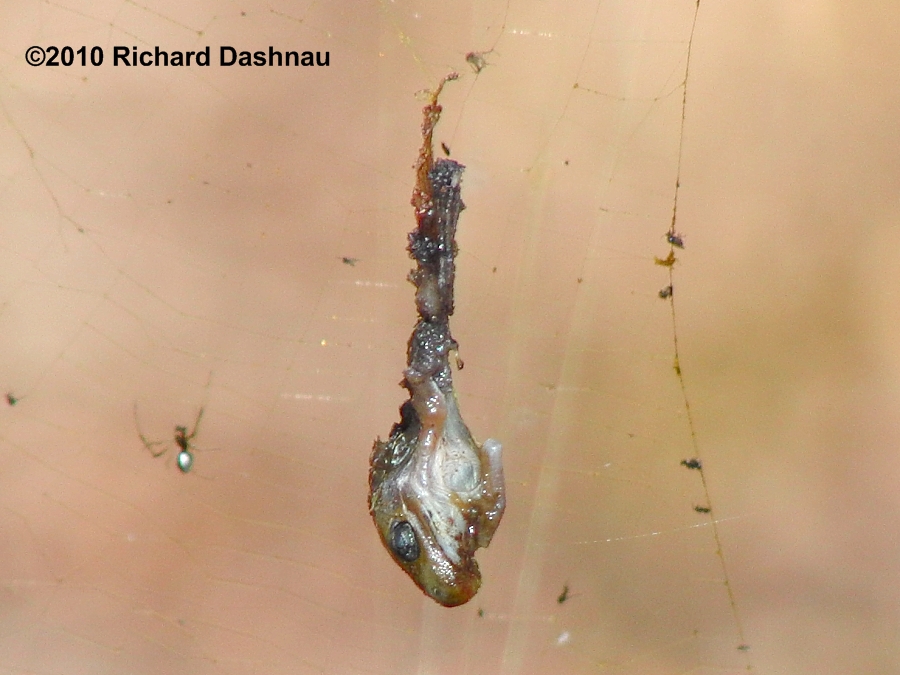 -
-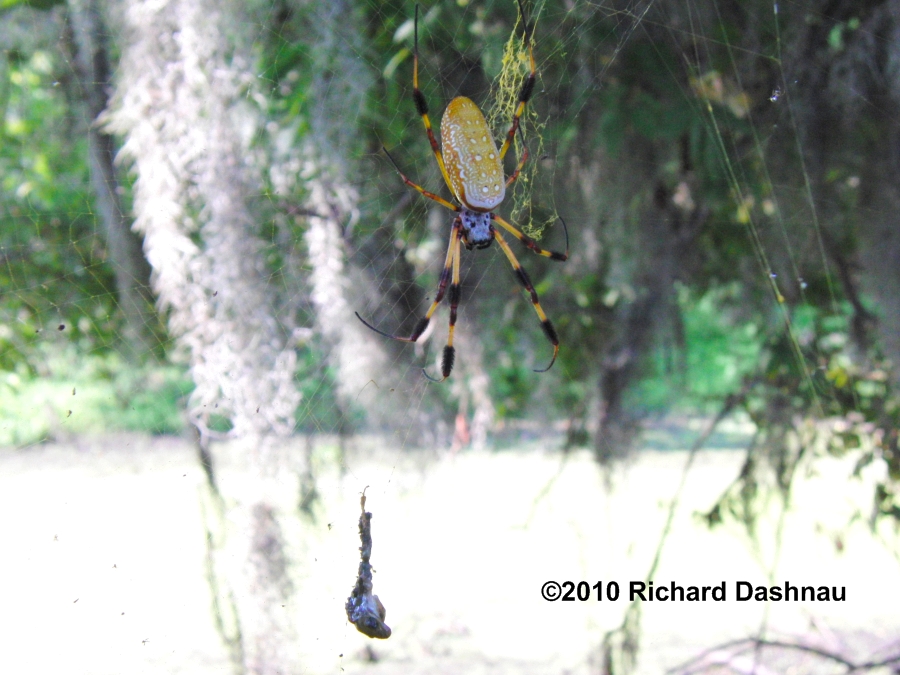 -
-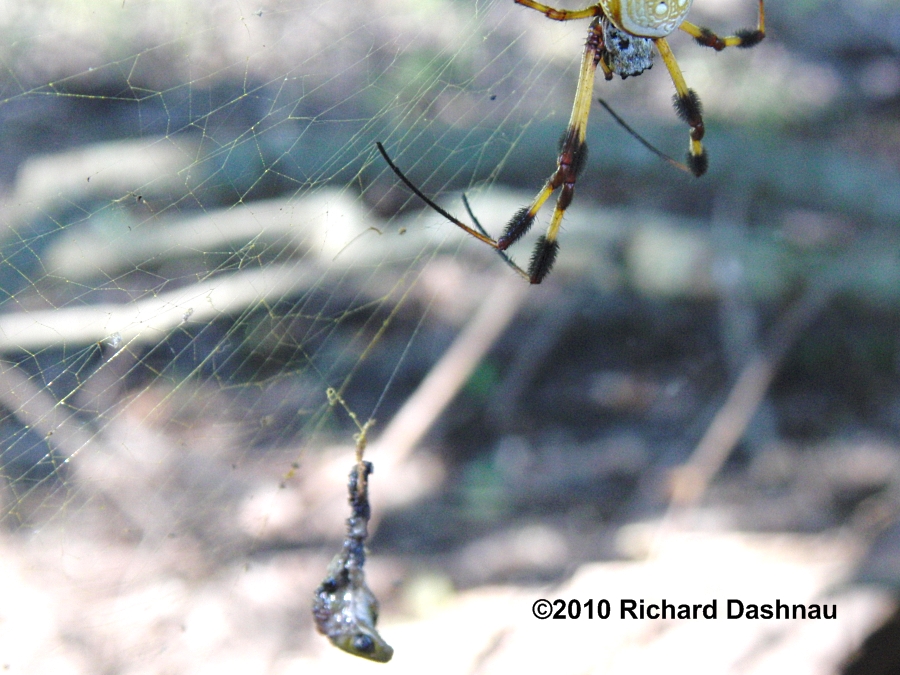
-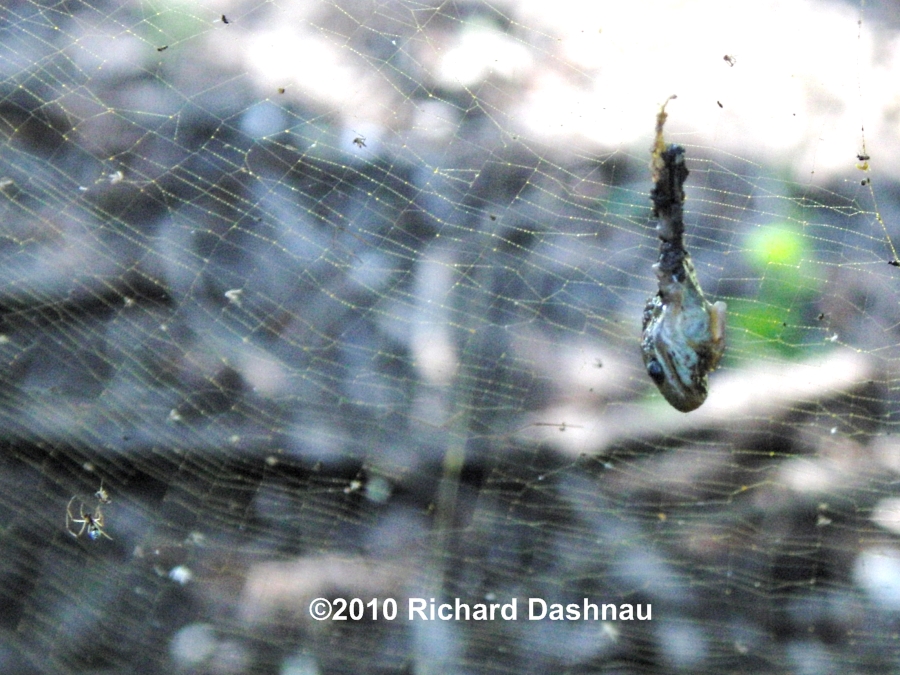 -
-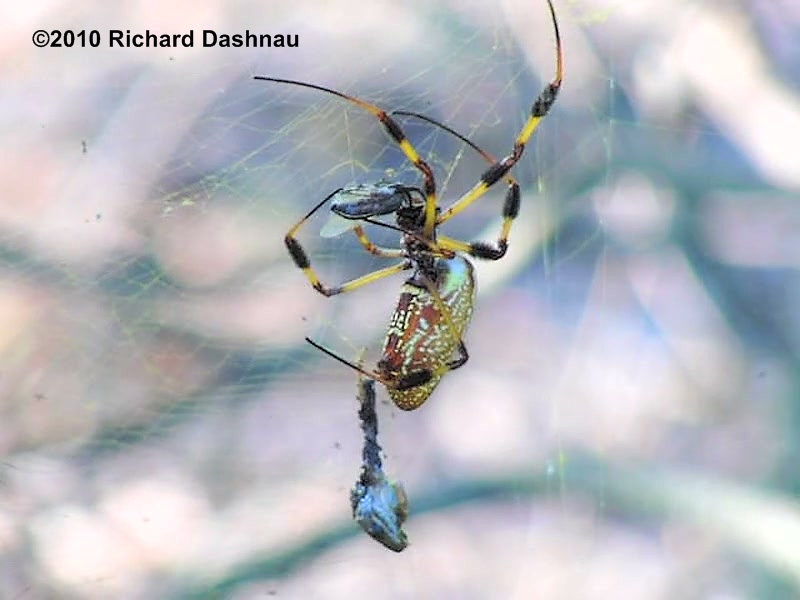 -
-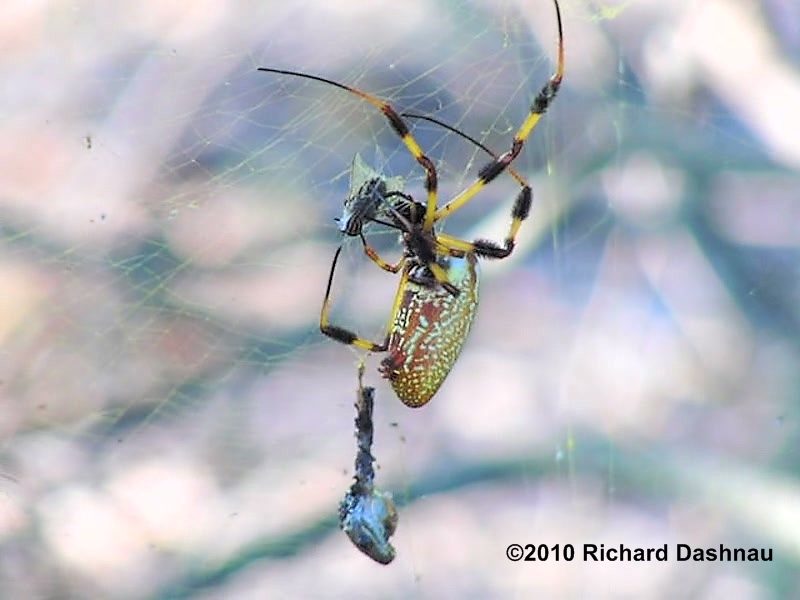 -
-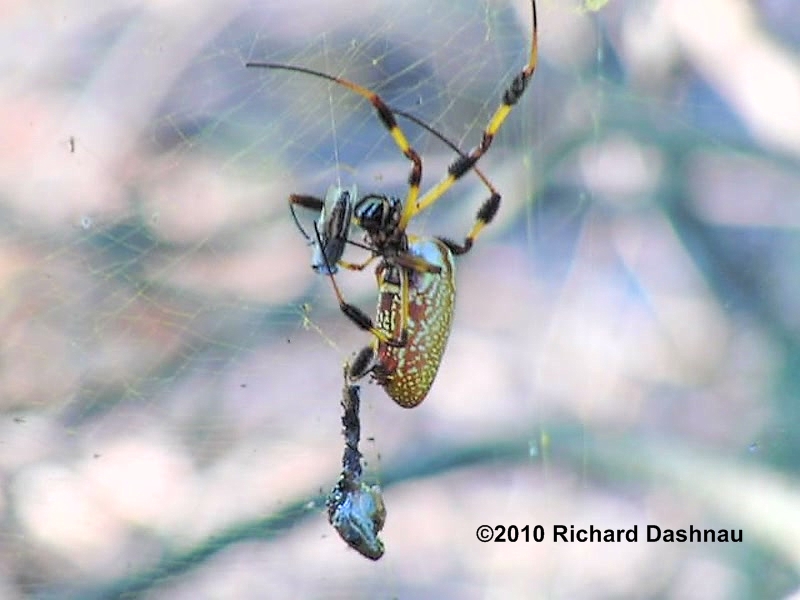
August 13 and years
before.
While we are walking the trails of Brazos Bend State park, we can
see
the
large webs made by the Golden Silk Spiders (Nephila Clavipes).
Centered
in the webs
are the large females. Through most of the summer, if we look
a bit closer at the webs, we will find spiders that are quite a
bit
smaller
than the large females--which can have a leg span of about 4
inches. These
smaller spiders still have the same general shape and proportions
of
the
large females, but usually lack the large tufts of hairs on the
legs.
These
smaller spiders are male N. Clavipes.
One or more may appear on the web,
and they are usually positioned above the female, and often on the
opposite
face of the web. Sometimes they approach the female if she has
food,
and
sometimes they approach the female if she doesn't have
food--perhaps
for
"romantic" purposes.
---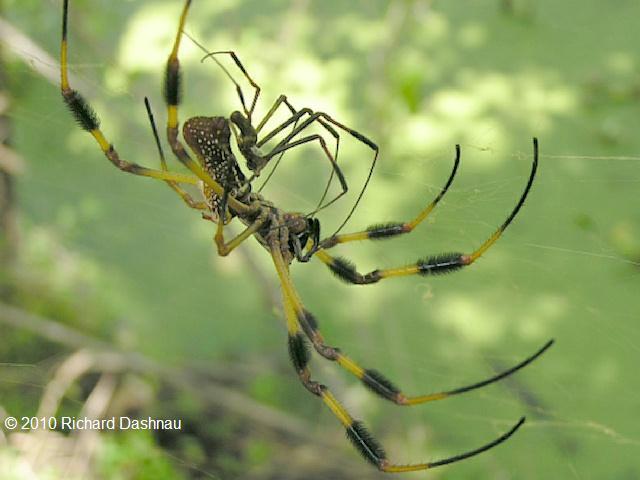 --
--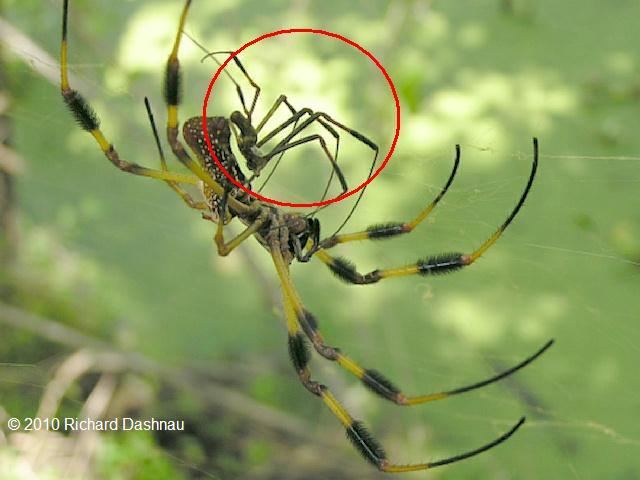 -
-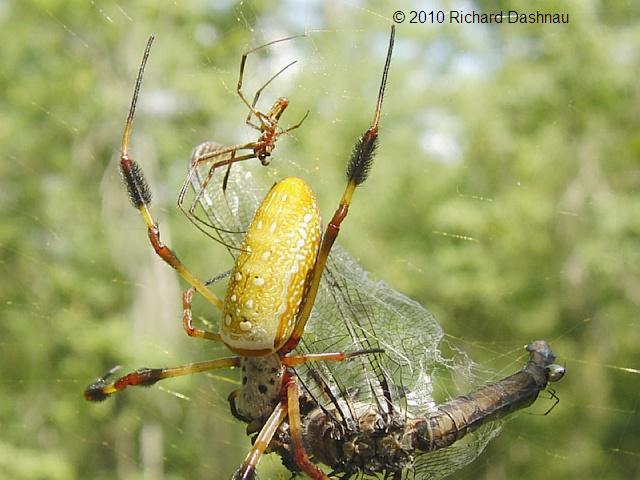 --
--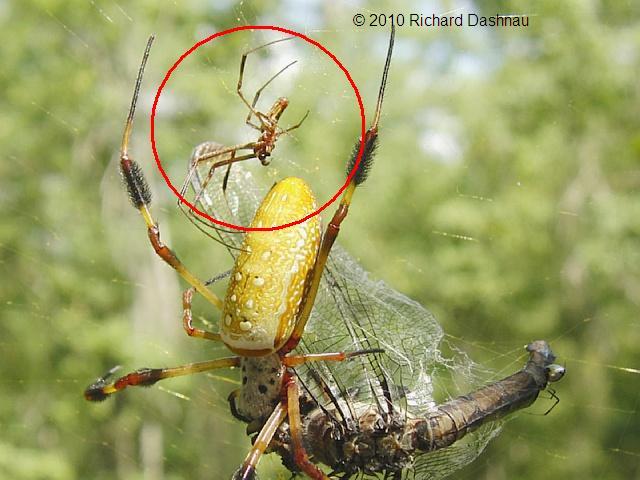
But,
if we look even closer, we might see small silvery specks in the
web.
Sometimes
the look almost like isolated dewdrops hanging there; silvery
dewdrops
glistening in the light. Silvery dewdrops
with legs.... Legs!? Wait a minute....
Those are SPIDERS!
--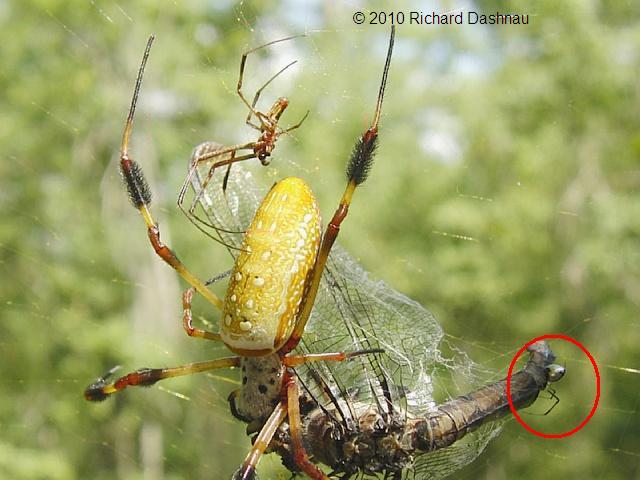 ---
---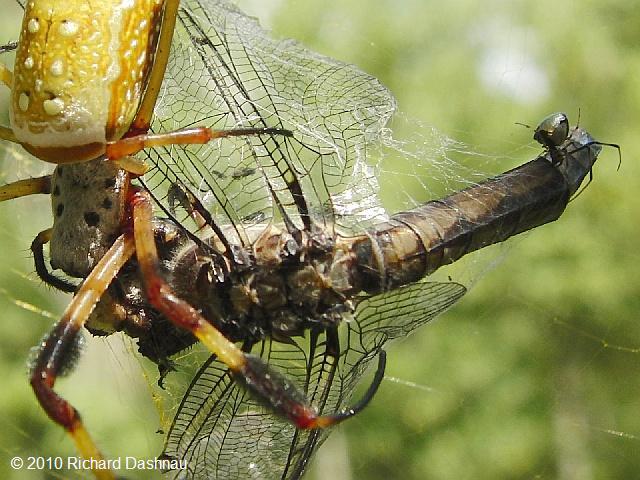 --
--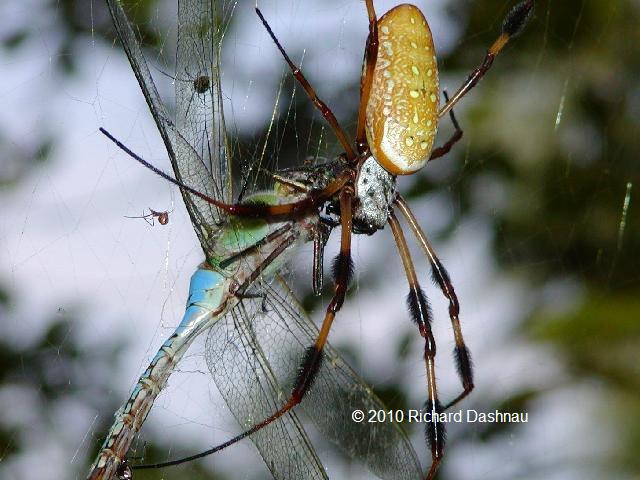 ---
---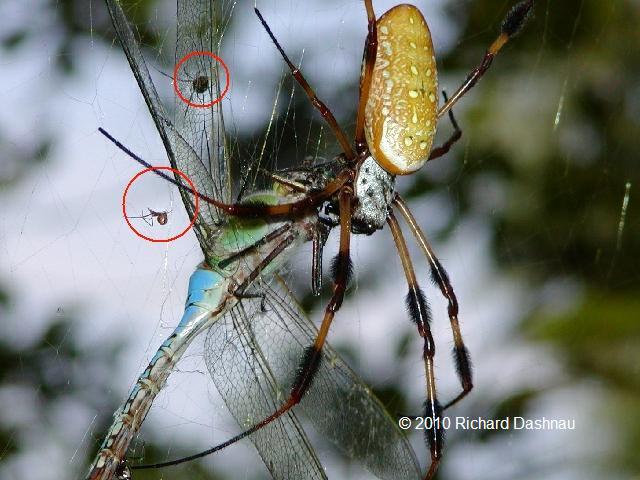
These
tinier spiders are sometimes called "Dewdrop Spiders", but are
more
precisely
known as Argyrodes (ahr-jee-RODE-eez). They live on the
habitat provided
by the large web made by the female
Nephila. When the female captures prey,
the Argyrodes sneak in and grab some of it. Since, in a way, the
large
Nephila's home acts as
a
"host" for the Argyrodes--and they steal food--Aryrodes are
called "kleptoparasites".
I've caught some of this activity on video a few years ago, An
edited
clip
of this can be seen here
(mp4)
-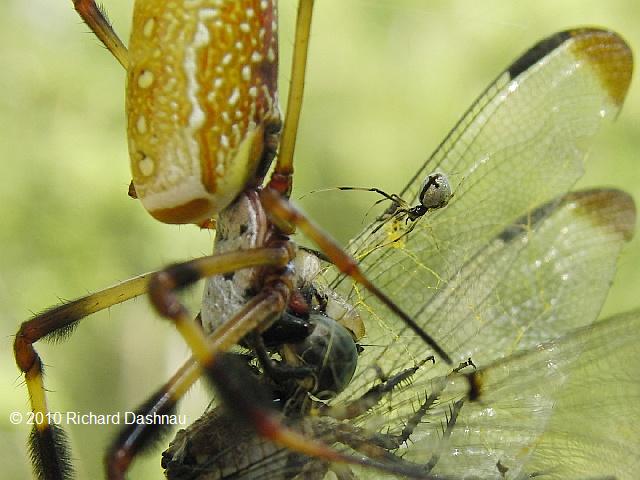 ---
---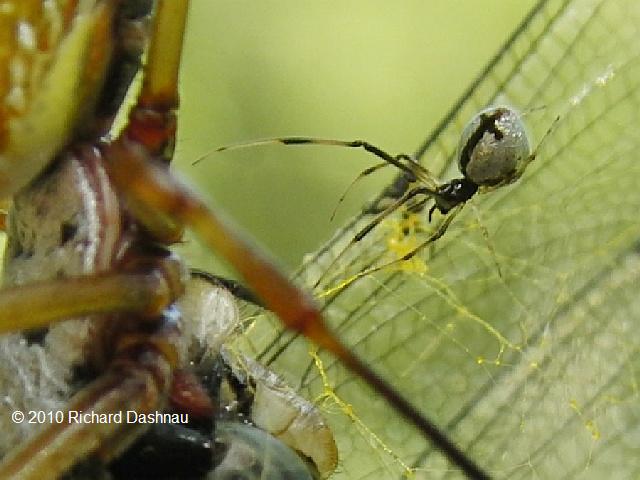 --
--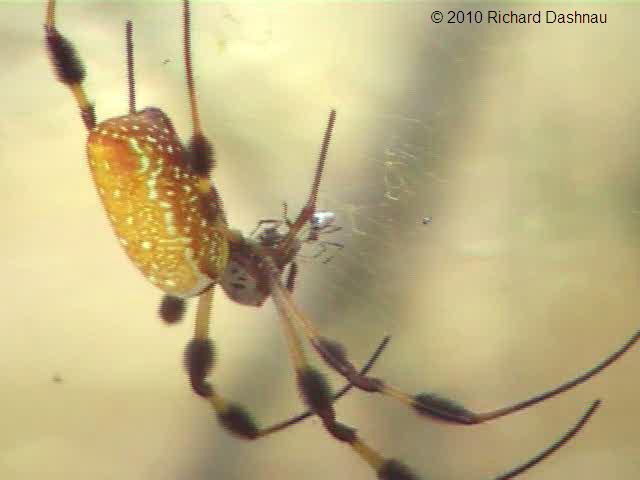 --
--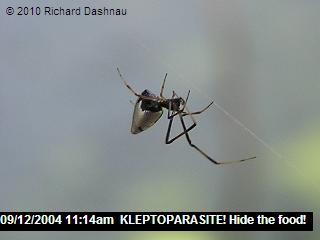
----------
Video
Clip
of Argyrodes (mp4)
According
to one study, Argyrodes might also sometimes prey upon "surplus"
male
Nephila
that are living on the web (The Life Cycle, Habitat and Variation
in
Selected
Web Parameters in the Spider,
Nephila Clavipes Koch (Araneidae)Clovis W.Moore
American Midland Naturalist, Vol. 98, Issue 1 (Jul.,1977),
95-108
(page 100))
Argyrodes
are grouped in the family of spiders called "theriididae",
or cobweb spiders.
This family has many members (over 2000), including the Black
Widow
spider,
and Common House spider.
June
20, 2004Also,
the Nephila Clavipes (the Golden Silk Spiders) population has
exploded.
They are visible everywhere. Most of them are similar in size, but
those
few that I'd seen on the trails
before must have hatched early.
------------------------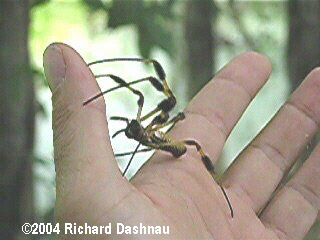 ---------------
---------------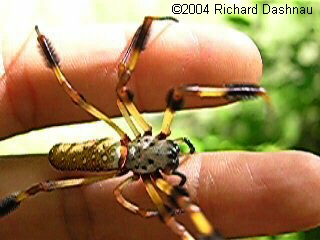
NEW NEPHILA,
2004
NEW
NEPHILA CLOSEUP
These
are much larger, and almost full grown. The picture above (NEW
NEPHILA
2004) is a frame from a short
video
clip (388kb) of one of these large females on my hand.
The other
picture (NEW
NEPHILA CLOSEUP) is a frame from another
short
video clip (535kb) showing a closer view the same
female.
-------------------------------------------------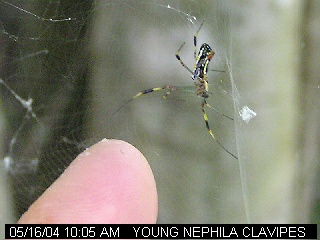
YOUNG
NEPHILA CLAVIPES
May
16, 2004The
picture above (YOUNG NEPHILA) shows something I've been watching for
for
the last few weeks. That is the hatching of the Golden Silk Spiders,
(Nephila
Clavipes). I've been
checking the Spillway Trail since the beginning of
May, but I haven't seen a large number of young Nephilas anywhere.
The
image shows my index finger near one of these young spiders,
although
at
this size, it's evident that it hatched some time ago. It's still a
lot
smaller than the adult spiders, though.
---------
-----------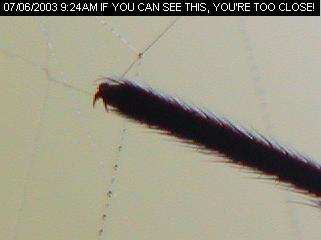 ------------
------------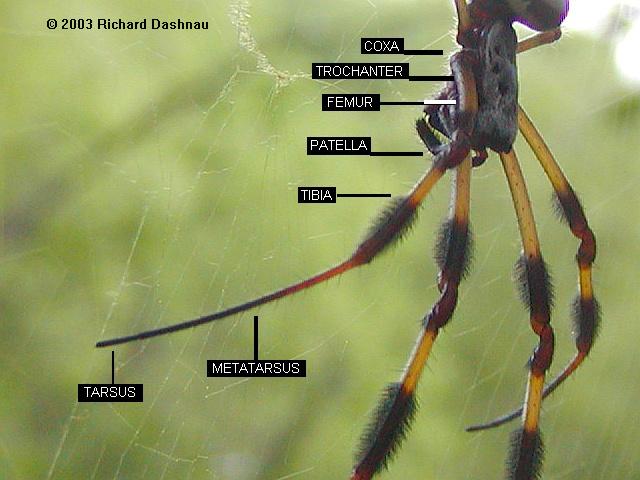
BIG
TROUBLE
LEG
SECTIONS
July
06, 2003Have
you guessed what the image BIG TROUBLE (above) shows? Well, when I
said
"too close" in the caption, I meant that if you can see something
this
without any optical enhancement,
then you're in BIG TROUBLE. This
is a macro photo of the end of the leg of a Golden Silk spider,
grasping
one strand of its web (see BIG TROUBLE, above). At this distance,
you'd
have to be stuck in
a web--this is a sort of "prey's-eye" view of your
approaching dinner guest; with dinner, of course, being YOU.
Since
last year, I've taken a lot of these--but haven't quite been
successful.
I finally bought
a macro slide for my camera, and this gives me much more
control. However, the wind still moves the web just as I'm about
to
take
a picture. I'm still working on it. For now, these will do. I've
been
waiting
for the Nephilas to hatch and get large enough.
Why
don't spiders get stuck on their own web when they walk on it?
Spiders
have 8 "walking legs". These each have 7 segments. The picture
above
(BIG
TROUBLE) shows the last of these segments, the tarsus. (in order
from
the
outer end, the segments are: tarsus,
metatarsus, tibia, patella, femur,
trochanter, and coxa; click on the LEG SECTIONS image above to see
640
x 480 image). All spiders have claws (two or three) at the end of
the
outermost
segment (see
CLAWS FROM THE SIDE, below). The Nephila Clavipes (and other
spiders who hunt by using a hanging web), uses an interesting
method to
walk on its web. The two "main claws" (which have serrations
on them) are
not used for this at all (see CLAW FROM UNDER). Instead, there is
a
smaller,
smooth claw between these two larger hooks. Look closely at the
first
two
pictures, and the RICKUBISCAM, and
you'll see that the large claws are
not holding the web at all.
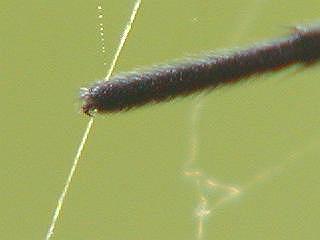 -
-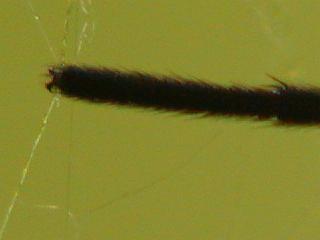 -
-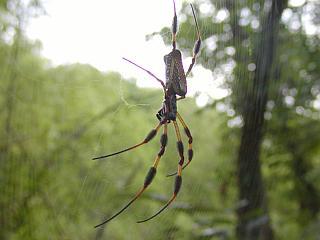 -
-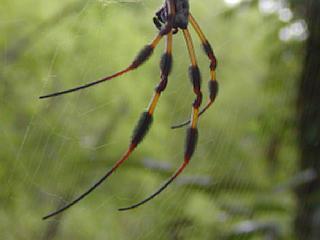 -
-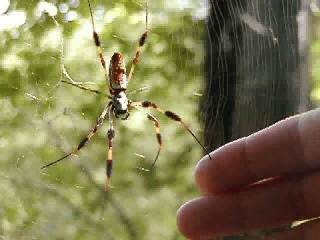
CLAW
FROM THE SIDE
CLAW
FROM
UNDER
THE LEG MODEL
HER LEGS,
CLOSER
LET'S SHAKE...HANDS
This
claw can fold in and back out. There are also two stiff hairs
alongside
this claw. The spider, when it wants to grasp its web, puts the
web
between
the folding claw and the two hairs, so the hairs are
on one side of the
web, and the claw is on the other. The claw then folds in, and
presses
the strand of web against the two hairs. This pressure slightly
bends
the
web across the hairs, and allows the spider
to hold onto it. To release,
the spider relaxes the muscles which pull the hook, and the web
springs
back out. The next time you see a spider walking its web, note how
only
the very tips of its legs touch the
web (see LEG MODEL, and CLOSER, above).
These second two are pictures of the female that I photographed.
At one
point, the wind blew her web into my macro slide, and she wasn't
very
happy
about
it. She ran over and seemed to be trying to push it out of her
web.
After taking the macro pictures, I decided to "shake hands" with
her
(see
SHAKE HANDS, above). This video
clip (flv video, 359 kb) shows
how she reacts to my finger. Notice
how she tests my fingers with her legs. Spiders have sensory
"hairs" on
their legs, and on various parts of their bodies. Some of these
hairs
can
sense motion in the air,
some of these are used to "taste". I am reluctant
to bother animals in the park, and felt that leaving her in
contact
with
her web would be a more pleasant interaction. See how calm she is?
See
how big she is,
compared to my right hand?
As
I've
noted before, I've used: The Biology of Spiders, by Rainer F.
Foelix,
published
in 1996, as a reference.
May
11,
2003
Yes, folks--the Golden Silk Spiders have returned. Previous
visitors to
these pages may recall their appearances here. If you can't
remember,
go
vtake a look at the top of this page to refresh your
memory. They are also
known locally as "banana spiders"--but are NOT the highly
poisonous
"banana
spider" which is known elsewhere (that's the Brazilian Wandering
Spider--phoneutria
fera.) I've been watching
to see if I could see these come out of their
egg sacs (according to a paper I've read, they actually hatch in
the
fall,
and live in the egg sac through the winter), but I hadn't had a
chance
to visit their area. I did this
today. There were large clumps of webbing
here and there (these ranged in size from about 1 foot to 3 feet
across-spreading
across branches and leaves.). This almost appeared like tent
caterpillar
webbing, but
closer inspection revealed small (some were TINY) spiders
within (see WEB CLUMPS, below. This image links to a LARGE 800 x
600
jpg.)
I saw a few spiders were already about an inch long, though.
Some
were quite small, and I suspect the males and females are close to
the
same size at this time. (see TINIER ONE, below) The image below
(NEW
NEPHILA)
shows my the tip of my finger pointing at one of these
spiders. The view
is from the bottom of the spider. Quite a bit different from the
picture
on the other pages with my hand, right? The third images shows one
of
the
bigger ones (see ONE INCH, below), from the top
of the spider. The rows
of spots are there, as well as the hairy joints. The fourth
image
(JUST A YOUNGSTER!, below) shows my index finger with another
one.
No, I'll never learn. This image is a frame from a
short
video clip (333kb, flv video). Quite a size difference from
thisvideo
clip(473
kb) of an adult one in my hand!
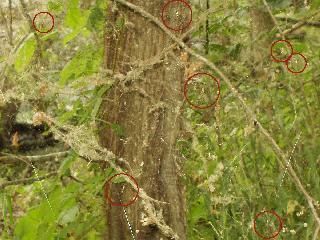 -
-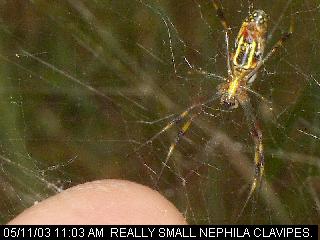 -
-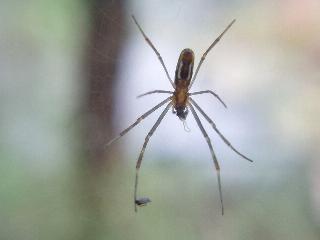 -
-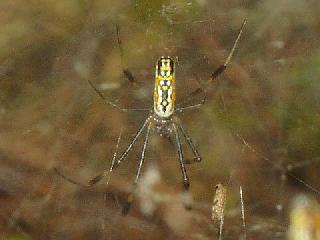 -
-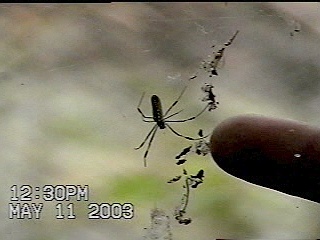
WEB
CLUMPS
NEW
NEPHILA
TINIER
ONE
ONE INCH LONG
JUST
A YOUNGSTER!
----------------------------------------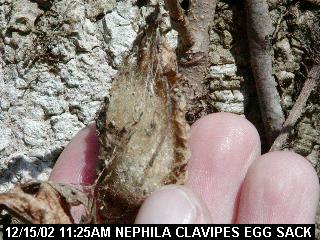
EGGS, NO SPAM
December
15, 2002Those
who
have previously visited this page may recall the Golden Silk
Spider
(Nephila Clavipes). A a result of the cold weather and rain we've
been
having, it's possible that they are finally gone for the
year. However,
thanks to some information loaned to the park by one of our
visitors
(Thanks,
Brittany!) I have more information about these spiders than I'd
seen
before.
Because of this information, I became curious about
the Nephila egg sacks.
I decided to see if I could find any. The picture above (EGGS, NO
SPAM)
shows that I was successful. Actually, I went out looking and
found
them
*last* week, but decided to look again today.
November
17, 2002The
pictures
below once again features that fuzzy-jointed arachnid friend
of
mine, the Nephila clavipes. Over the last week, temperatures have
dropped
(not that you folks up North would be sympathetic
to this) to the 30s in
various parts of Texas. Here, we've experienced temperatures in
the low
40's. Between this, the wind, and all the rain, the multitudinous
orb
webs
belonging to the Golden Silk spiders (Nephila clavipes)
have all but cleared
out along the Spillway Trail. I found this one resting on a
bunched
strand
of web ("bunched", in that it seemed to be made of several strands
twisted
together.) Since this could likely be the last time I'd be
seeing
one, I decided to get a little closer than usual, and see if I
could
entice
her to climb onto my hand. I took two short video
clips of
this Nephila slowly moving on the strand (part
1(486kb) see STRANDWALK PART 1,
below; part
2(469kb) see STRANDWALK PART 2,below) and then one
short one
(my
hand(473kb) see RICK'S
HAND, below.) of her stepping on and off my hand. She actually
climbed
on it after this, but I couldn't film it,
since I was trying to make sure
she a) didn't fall off, and b) didn't run to the nearest warm
spot--like
up my sleeve to my neck. She eventually tired of me, and slowly
made
her
way up a tree and out of my reach. I'll mention here
that there were *very*
few webs visible, and aside from this large female, the other
spiders
(*maybe*
15 webs remained on the entire trail to the spillway) were about
half
this
size.
---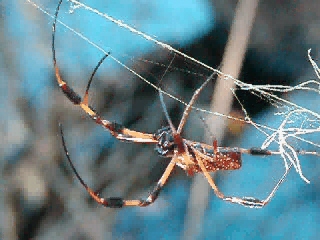 ------------
------------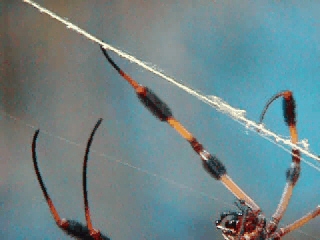 -----------
-----------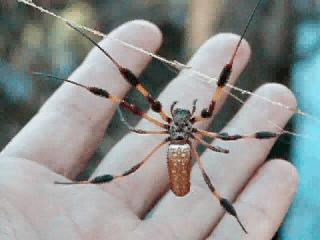
STRANDWALK PART 1
STRANDWALK PART 2
RICK'S HAND
Notice
how she grabs the strands of web. Spiders that spin orb webs can
walk
on
their webs--and not get stuck--by using an interesting adaptation
to
the
ends of their walking legs. All spiders have claws at the ends
of
their
walking legs--either two or three claws at the end (this can vary
from
species to species). However, the "web-walking" spiders do NOT use
these
claws for web-walking. Instead, they have specialized hairs at
the
end
of their legs--three of them, and these are between the
claws. It
is these specialized hairs that move around the web (with the web
acting
sort of like a piece of hair getting caught in the teeth of a
comb),
and
"pinch"
on the strand (source:
Biology of
Spiders-2nd edition, by Rainer F. Foelix.).
I have been trying to get macro shots of this particular function
ALL
SUMMER;
with limited success. What I've been able to capture will
eventually end
up here.
October
13, 2002A
cold front blew through today. The picture below (TIGHTROPE) shows
one
of our park spiders (those Golden Silk Spiders) sort of
dumbfounded by
the temperature drop. This spider had a large
dragonfly in its web, but
didn't eat much of it. As I was watching it crawled down a strand
of
web
to a one of the anchor points, then turned around and returned to
its
orb.
It was apparently doing a little web repair. Click
here(flv
video
477kb) to see a short video clip of its movements.
When it pauses,
you can see it attach a strand of silk to the anchor thread and
then
begin
walking. Also notice how it grabs each strand with the
very
end of
its legs as it moves. As soon as I get a little time, I'll
be
putting
some more information here about the interesting machinery that a
spider
has to work with. I won't have much more time to get pictures of
them
before
they'll be gone for the cold season.
---------------------------------------------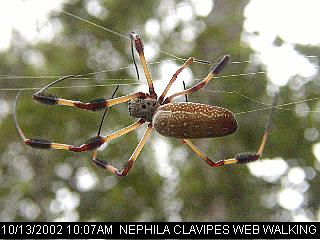
------------------------------------------------
---TIGHTROPE
-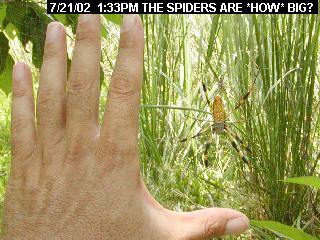 ------
------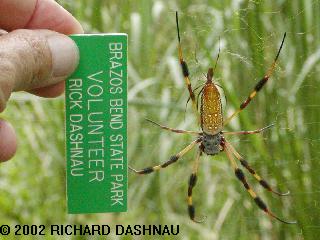 --------
--------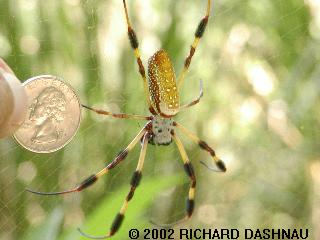 ----
----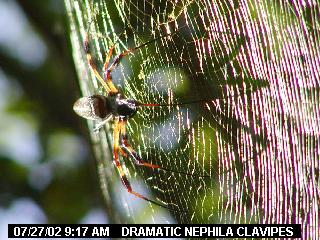 ------
-------
------
-------
HOW
BIG?
IT
DIDN'T CATCH MY NAME
WITH A
QUARTER
DRAMATIC LIGHTING
July
21-20, 2002 I
guess we're moving into
our summer weather, although it hasn't broken 100 degrees F yet.
The
number
of visitors to the park has lessened somewhat. Today,
July 21(Sunday),
I took a few more pictures of some of our Golden Silk Spiders.
This
picture
shows a pretty big one (see HOW BIG?, above). I took two
more
pictures
of this one,
with different objects to give a better idea of the size.
(See CATCH MY NAME, and WITH A QUARTER above). These spiders are
usually
harmless to humans, but it still gave me
some heebie-jeebies to look through
the camera zoomed in as I moved my hand closer to the spider. I'll
mention here that Ms. Kissane, in our early communication,
pointed out
the
there is a very poisonous, and aggressive spider from South
America
also known as "Banana Spider", because it has turned up in
shipments of
bananas here in the U.S. Please
don't start killing the spiders I've shown
here under the impression that these "Banana Spiders" are the
same.
They
aren't.
Unlike
insects, which they superficially resemble, spiders have 2 main
body
parts,
cephalothorax, sometimes called the "prosoma" on spiders, and the
abdomen,
also called the "opisthosoma" on spiders.
The two main body parts
are joined by a thin joint called the "pedicel" (Source for body
part
names:
Biology of Spiders-2nd edition, by Rainer F. Foelix.) Click
the image
below to see these parts labeled on
a real spider, which happens to be
a Nephila clavipes.
-------------------------------------------------------------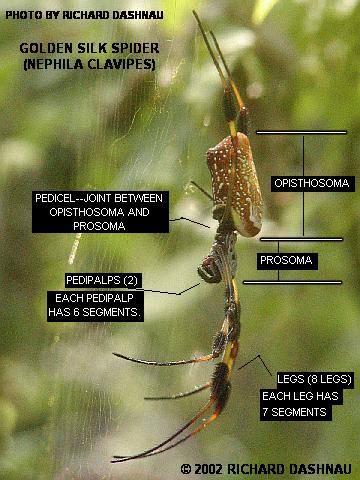
July
7, 2002 I've noticed
some visitors (and some
websites) have shown some confusion regarding two large,
conspicious
spiders
that can be seen at Brazos Bend State Park. s I mentioned, other
things
happened
this weekend, and I'll be adding these when I have time. These
are the Black and Yellow Argiope (aka Golden Orb Weaver) and the
Golden
Silk Spider (aka Banana Spider). These two spiders are
pictured below.
These are all pictures that I took at the park.
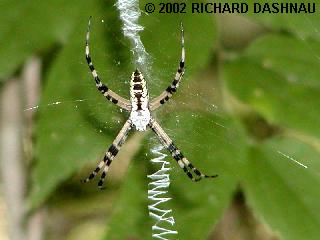 -
-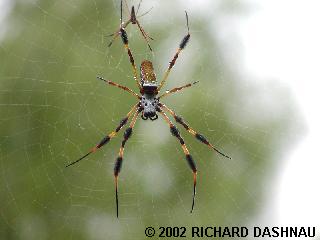 -
-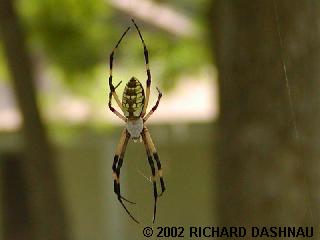 -
-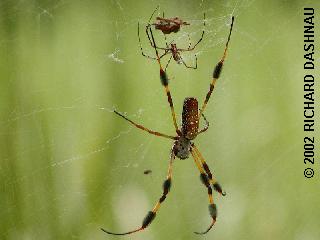 -
-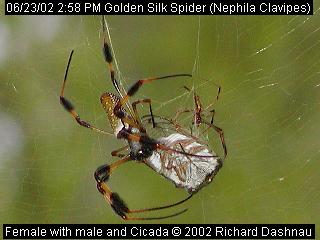
BLACK
& YELLOW ARGIOPE
GOLDEN
SILK SPIDER
BLACK & YELLOW ARGIOPE
GOLDEN SILK
SPIDER
GOLDEN SILK SPIDER
The
Black and Yellow Argiope (Argiope aurantia) has an oval-shaped
abdomen
(which may narrow when the spider hasn't fed for a while), and
black
and
yellow blotches, as shown. Also, the joints of the legs are
smooth, and
the completed orb web has a very obvious zig-zag pattern near the
center.
The
Golden Silk Spider (Nephila Clavipes) has a bent, or
rectangular-shaped
abdomen (which can be a bit distended if the spider
has been fed), and
rows of spots on a brownish or orange background. Also, the leg
joints
have hair, an the completed orb web has no zig-zag pattern. It
also
seems
that the Golden Silk Spider gets much larger than the Argiope.
June
23, 2002 The
spider in the image below
( Golden Silk) features a large spider sometimes called a "Banana
Spider"
because of the curved shape of its yellowish abdomen. They are
abundant
at Brazos Bend State Park,
particularly along the trail between Elm Lake
and the Observation Tower (also known as "Spillway Trail"). Some
spots
along this trail look like something out of an Indiana Jones
movie,
with large groups of big spiders hanging
in a mass of webs. The female
of this species is about 5 times the size of the male. The name
"Golden
Silk Spider" comes from the gold tint that can be seen in the web
when
the light hits it just right.
-- ----
----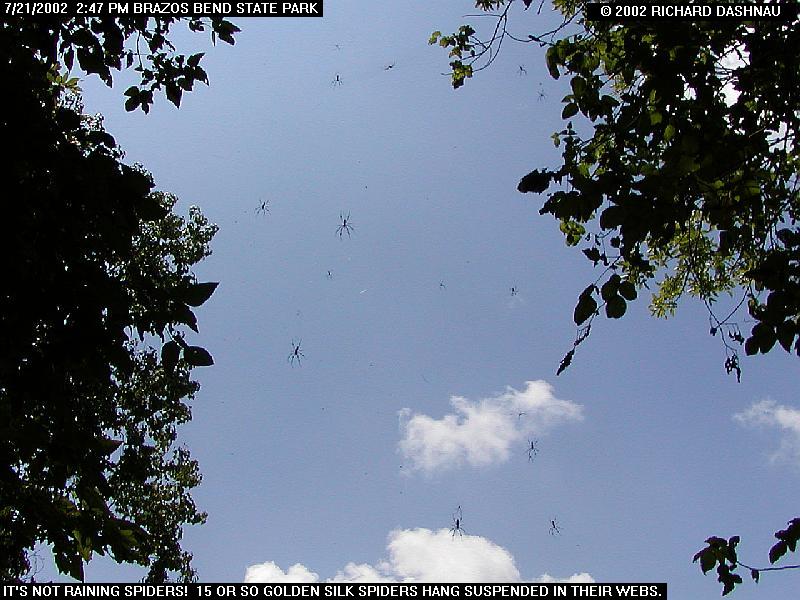 ----
----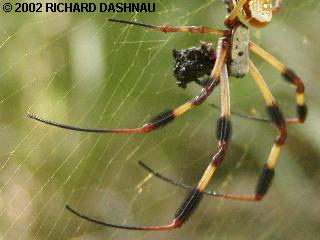
GOLDEN SILK
MANY
GOLDEN SILK SPIDERS! CLICK
TO ENLARGE (800 X
600)
IT'S EATING!
If
you'd like to know more about the park follow these links:
Brazos
Bend
State Park
The main page.
Brazos
Bend
State Park Volunteer's Page The
volunteer's
main page.
Click
on this image 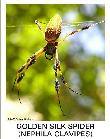 to see a flv video movie (942kb) of a series of 9 11 x 14
posters
I'm working on.
to see a flv video movie (942kb) of a series of 9 11 x 14
posters
I'm working on.
Go
back to my home page, Welcome
to rickubis.com
Go
back to the RICKUBISCAM
page.
Go
back to the See
the
World
page.
 -
- -
- -
-
 -
- -
- -
-















































